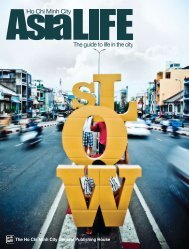Nam Ky Khoi Nghia - Asialife HCMC
Nam Ky Khoi Nghia - Asialife HCMC
Nam Ky Khoi Nghia - Asialife HCMC
Create successful ePaper yourself
Turn your PDF publications into a flip-book with our unique Google optimized e-Paper software.
American chiropractor Wade Brackenbury has traversed the globe’s least<br />
explored regions—guerrilla-occupied Guatemalan jungles, the inner<br />
mountains of Tibet, the Congo’s depths—all in a quest to find meaning.<br />
Beth Young speaks to Brackenbury about his extraordinary journeys.<br />
A conversation with American<br />
expatriate Dr Wade Brackenbury<br />
is peppered with exciting<br />
anecdotes about his vast travels—from<br />
an encounter with<br />
an angry Melanesian giant in<br />
Papua New Guinea, to a search<br />
for archaeological treasures<br />
in Central America aboard a<br />
handmade raft.<br />
The chiropractor-cumadventurer,<br />
it would seem, is<br />
as comfortable in the outdoors<br />
as he is adjusting a problem<br />
back or administering Korean<br />
acupuncture.<br />
What’s most unique about<br />
Brackenbury though is his<br />
inability to give up. While his<br />
expeditions have been far from<br />
easy, this atypical traveller sees<br />
his plans out from beginning<br />
to end—regardless of what<br />
obstacles may arise.<br />
Early Adventures<br />
Brackenbury’s wanderlust began<br />
as a teenager. Growing up<br />
in a small country town with a<br />
population of just 400 spurred<br />
him to see the world, and living<br />
close to the earth—his parents<br />
owned a ranch—piqued his<br />
interest in societies that rely<br />
totally on nature.<br />
His first trip was a plan<br />
hatched with a close high<br />
school friend. The two fledgling<br />
explorers had just watched an<br />
Indiana Jones film and were<br />
inspired by the archaeologist’s<br />
exploits. Though they knew<br />
little about the country, they<br />
decided to walk across Australia.<br />
It was a feat they quickly<br />
realized would be difficult.<br />
“We got this map out of Australia<br />
and both said ‘Oh look at<br />
all that desert. That might be<br />
tough!’ But we decided to go<br />
anyway,” he laughs.<br />
The pair amended their<br />
itinerary, but only slightly. They<br />
hitchhiked across New Zealand<br />
and Australia for three months,<br />
before Brackenbury travelled<br />
alone to Papua New Guinea.<br />
There, he spent four months<br />
hiking to the tip of the highlands<br />
that separate the country<br />
from Indonesia Papua.<br />
Even this first trip was anything<br />
but smooth. Brackenbury<br />
flew a mail plane into the country’s<br />
interior and directly into<br />
a feudal war—a hiccup that<br />
didn’t faze him in the slightest.<br />
What finally sent him home<br />
was a run in with a drunken<br />
local man that left Brackenbury<br />
and his female companion<br />
beaten to a pulp.<br />
He still had the travel bug<br />
though. Back in America he<br />
studied for a few years before<br />
setting off on another journey,<br />
this time to Guatemala.<br />
His companion was a young<br />
woman who was studying Mayan<br />
culture. Together they rode<br />
a motorbike from Mexico City<br />
to Guatemala, then all the way<br />
to the head of the Pasion River,<br />
where a group of Mennonite<br />
missionaries helped them build<br />
a raft.<br />
They floated the raft for a<br />
month looking for undiscovered<br />
ruins. “We were hoping<br />
to find some Mayan gold. We<br />
had some amazing adventures<br />
instead,” says Brackenbury.<br />
At the time, the country was<br />
embroiled in a civil war, and at<br />
night when the pair stopped to<br />
camp in the jungle, Guatemalan<br />
guerrillas would often stop by<br />
to investigate. “It was worrisome,<br />
but nothing bad ever<br />
happened,” says Brackenbury.<br />
Next Stop<br />
Brackenbury’s later voyages<br />
were more purposeful. His<br />
skills as a kayaker and mountaineer<br />
made him an invaluable<br />
asset for an anthropological<br />
trek through Western Africa<br />
in 1997, and he was hired as a<br />
paramedic.<br />
The expedition’s goal was<br />
to gauge how Eboli outbreaks<br />
in the region had affected the<br />
local people. However, the tour<br />
leader had a nervous breakdown<br />
and abandoned the expedition<br />
early on. Everyone was<br />
expected to return home, but<br />
Brackenbury stayed on. “We<br />
didn’t want to go home and<br />
fail. There was a lot of pressure<br />
to quit though,” he says.<br />
A 17-year-old American boy<br />
also remained, and the two<br />
travelled through the Nadoki<br />
Swamp across the Congo,<br />
where they lived with a pygmy<br />
tribe for two months. Brackenbury<br />
admired the pygmies’<br />
respect for nature and their<br />
gratitude to the Earth. As such,<br />
Brackenbury and his companion<br />
emulated the pygmies. “I’d<br />
read one book and then I’d give<br />
it to him to read. When he was<br />
finished he’d cut the pages out<br />
to build a fire.”<br />
A trip to innermost Tibet is<br />
Brackenbury’s most memorable<br />
and meaningful adventure<br />
though—perhaps because it<br />
44 asialife <strong>HCMC</strong> asialife <strong>HCMC</strong> 45















